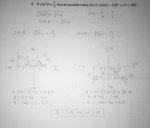Hello,
I'm having some difficulty understanding a negative domain and how that works with calculating a reference angle and rotational angle. Attached are screenshots of practice questions Im working on and got incorrect but I don't know why they're incorrect. Could somebody walk me through this please? I full understand positive domains, just lost with the negative ones. Maybe I'm missing something really obvious? I feel silly asking this but I spent some time watching youtube videos and still don't get it.
For the picture with the 45-90-46 triangle in the top right - why do we subtract 60 from 0?
Thanks in advance.


I'm having some difficulty understanding a negative domain and how that works with calculating a reference angle and rotational angle. Attached are screenshots of practice questions Im working on and got incorrect but I don't know why they're incorrect. Could somebody walk me through this please? I full understand positive domains, just lost with the negative ones. Maybe I'm missing something really obvious? I feel silly asking this but I spent some time watching youtube videos and still don't get it.
For the picture with the 45-90-46 triangle in the top right - why do we subtract 60 from 0?
Thanks in advance.





